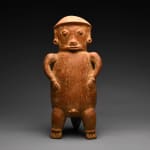Terracotta Male Figurine, 200 CE - 500 CE
Terracotta
height 33 cm
height 13 in
height 13 in
PF.3123
Further images
The sheer delight of this figurine makes him a focus for collectors who seek an alternative to the iconographically dense art of the Maya or Aztecs. Lively and content, he...
The sheer delight of this figurine makes him a focus for collectors who seek an alternative to the iconographically dense art of the Maya or Aztecs. Lively and content, he stands gallantly with his hands resting firmly at his waist. Either an important chieftan or shaman-chieftan, there are remarkable incised geometric designs covering him. The designs may represent the sacred web of the cosmos with east-west and north-south directions or have specific religious or political connotation. The incisions have been richly preserved for our enjoyment and admiration today. His earspools, bracelets and anklets were probably made of the most precious materials: jade, serpentine, or other greenstones, along with obsidian or gold. All of which had symbolism and meaning to the ancient inhabitants of Costa Rica. During ceremonial rituals and festivities, this ancient figurine was likely to have been set on an altar or next to other sacred and significant relics. He stands before us as a witness of long forgotton sacred ceremonies with his lips slightly opened ready to share his testimony of a great and prosperous culture.





